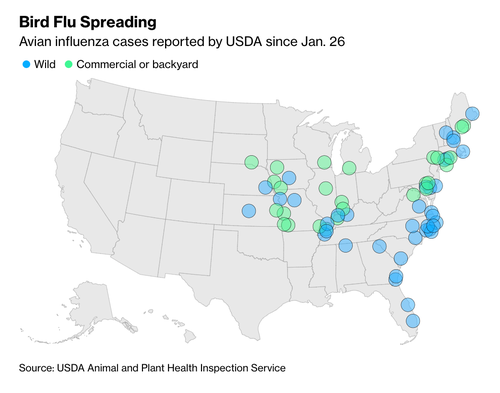Egg Prices Soar As Highly Pathogenic Bird Flu Spreads Ahead Of Easter
Add eggs to the growing list of food prices rising at grocery stores. The reason is a highly pathogenic avian influenza (HPAI) spreading across the US.
Bloomberg reports HPAI has been detected in commercial poultry operations, backyard farms, and wild flocks up and down the East Coast and across the Midwest since Jan. 26.
The United States Department of Agriculture’s (USDA) Animal and Plant Health Inspection Service (APHIS) has monitored the spread rippling through the US. Standard procedures for farms where HPAI has been detected are cull infected flocks. Last week, APHIS said 2.8 million chickens and turkeys died in one month from the virus. At least one million birds were recently culled at a poultry farm in Iowa.
Karyn Rispoli, a poultry market analyst at commodity researcher Urner Barry, warns egg prices are beginning to rise due to lost production. She said peak demand for eggs is underway as Easter fast approaches, pushing prices even higher.
HPAI spreading to more farms, thus triggering more cullings, risks future supply disruptions. As wholesale prices increase, consumers are expected to notice rising egg prices, just as inflation soars to four-decade highs.
Urner Barry data shows wholesale eggs jumped 10 cents to $1.60 a dozen Wednesday, the most significant daily gain since the early days of the virus pandemic. The five-year average for wholesale eggs is around $1.44.
John Brunnquell, CEO of producer Egg Innovations, said prices would continue rising in the coming weeks, and consumers will notice.
“Bidding remains very strong among different egg companies, and so you’re going to see significantly higher” prices at grocery stores, Brunnquell said.
Since the HPAI spread is recent, there’s no telling if it will abate anytime soon. The last outbreak, in 2015, resulted in the culling of 50 million laying hens across 15 states, pushing retail Grade A Egg prices to nearly $3 a dozen. Prices are currently at $2.
Retail prices are at the highest in five years for this time of year.
The largest concern is the spread of HPAI as wild flocks migrate across the country. Even before the emergence of the virus, the 2015 culling has resulted in declines in egg-laying chickens.
“When you layer that on top of that what’s going on with avian influenza, and the precedent of 2015, the impact on the market could be material,” Stephens analyst Ben Bienvenu warned.
Tyler Durden
Fri, 03/18/2022 – 19:20

